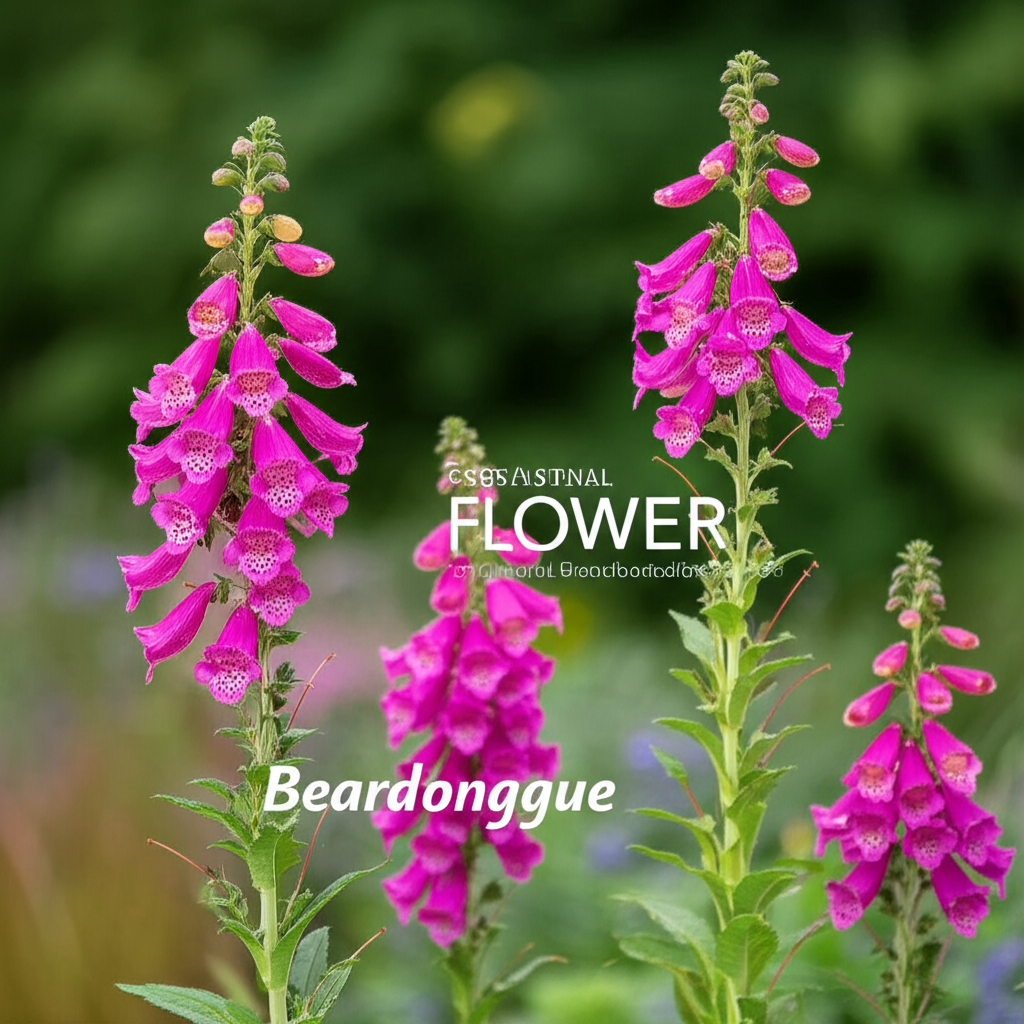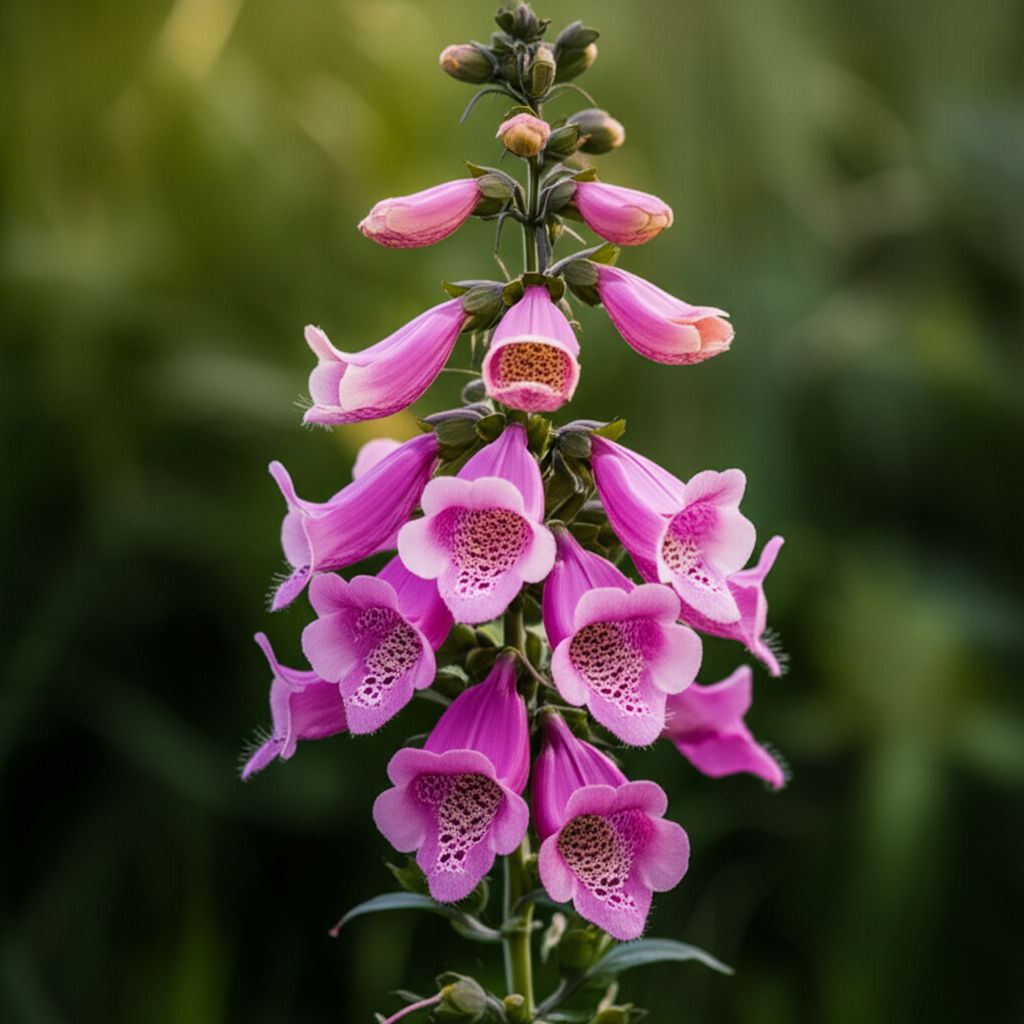Understanding Foxglove Beardtongue (Penstemon digitalis)
Foxglove Beardtongue, scientifically known as Penstemon digitalis, is a captivating native perennial wildflower that brings both beauty and ecological value to any garden. Revered for its tall, elegant spires of white to pale lavender, tubular flowers, this plant is a magnet for pollinators, including bees, butterflies, and hummingbirds. Its upright growth habit and attractive foliage make it a standout performer from spring through fall, offering seasonal interest even when not in bloom.
Native to the eastern and central United States, Penstemon digitalis thrives in a variety of conditions, making it a versatile choice for gardeners. It is particularly well-suited to moist, open meadows, prairies, and woodland edges, but can adapt to more cultivated settings with proper care. Understanding its natural habitat and growth patterns is key to successfully cultivating this valuable plant.
Key Characteristics of Foxglove Beardtongue
Before delving into seasonal care, it’s essential to understand the fundamental characteristics of Penstemon digitalis:
- Botanical Name: Penstemon digitalis
- Common Names: Foxglove Beardtongue, White Beardtongue, Foxglove
- Plant Type: Perennial wildflower
- Bloom Time: Late spring to early summer (typically May to July)
- Flower Color: White to pale lavender or pinkish-white
- Flower Shape: Tubular, with a bearded lower lip (hence “Beardtongue”)
- Height: 2-4 feet (60-120 cm)
- Width: 1-2 feet (30-60 cm)
- Hardiness Zones: 3-8
- Sun Exposure: Full sun to partial shade
- Soil Preference: Prefers moist, well-drained soils, but tolerates a range of conditions including clay and sandy soils.
- Water Needs: Moderate to high water needs, especially during establishment and dry periods.
- Attracts: Bees, butterflies, hummingbirds, beneficial insects
- Drought Tolerance: Moderate once established
- Deer Resistance: Generally deer resistant
Seasonal Care: A Detailed Approach

Proper seasonal care ensures that Foxglove Beardtongue remains healthy, vigorous, and continues to provide its stunning floral displays year after year. This involves understanding the plant’s needs at different times of the year.
Spring: Awakening and Growth
As winter gives way to spring, Penstemon digitalis begins its annual cycle of growth. This is a crucial period for providing the necessary support for a successful blooming season.
- Clean-Up: Remove any dead foliage from the previous year. This can be done in late fall or early spring. Cut back dead stems to about 2-3 inches above the ground. This tidies the garden and prevents overwintering pests or diseases.
- Mulching: Apply a layer of organic mulch (such as shredded bark, compost, or straw) around the base of the plants. Mulching helps retain soil moisture, suppress weeds, and regulate soil temperature, providing a stable environment for new growth.
- Fertilizing (Optional): Foxglove Beardtongue is generally not a heavy feeder and can thrive in average soils. If your soil is poor, a light application of compost or a balanced, slow-release organic fertilizer in early spring can be beneficial. Avoid over-fertilizing, which can lead to leggy growth and reduced flowering.
- Watering: Ensure the soil is consistently moist, especially as new growth emerges. Water deeply, encouraging roots to grow deeper into the soil.
- Pest and Disease Monitoring: Inspect plants for any signs of pests or diseases. Early detection is key to managing any issues.
Summer: Blooming and Maintenance
Summer is the prime season for Foxglove Beardtongue, characterized by its abundant flowering and the attraction of numerous pollinators.
- Watering: Maintain consistent moisture, especially during hot, dry periods. Water at the base of the plant to avoid wetting the foliage, which can contribute to fungal diseases. Deep watering is more effective than frequent shallow watering.
- Deadheading (Optional): While not strictly necessary for the plant’s health, deadheading spent flower spikes can encourage a second, albeit smaller, flush of blooms. It also improves the plant’s appearance by removing faded flowers. Cut the spent flower stalks back to a side shoot or the ground.
- Weeding: Keep the area around the base of the plants free of weeds, which compete for water and nutrients. Mulch also helps with weed suppression.
- Support: For taller varieties or in windy locations, consider staking the plants to prevent them from flopping over, especially when laden with flowers. Bamboo stakes or plant supports can be used discreetly.
Fall: Preparation for Dormancy
As the growing season winds down, Penstemon digitalis prepares for winter dormancy. This is a time for assessing the plant’s condition and preparing it for the cold months ahead.
- Leave Seed Heads: Do not cut back the flower stalks immediately after flowering. The dried seed heads provide visual interest throughout the fall and winter months and offer a valuable food source for birds.
- Watering: Continue to water as needed, especially if the fall is dry, to ensure the plant is well-hydrated before winter.
- Final Cleanup (Optional): Some gardeners prefer to cut back the dead foliage in late fall to prevent overwintering pests. Others leave it as is, providing winter interest and habitat for beneficial insects, and then clean up in early spring.
- Division (Optional): If your plants have become overcrowded or are showing reduced vigor, fall is an excellent time to divide them. This involves carefully digging up the plant and separating the root ball into smaller sections, each with roots and a crown. Replant the divisions immediately.
Winter: Dormancy and Protection
During winter, Foxglove Beardtongue enters a period of dormancy. While it requires minimal active care, understanding its needs during this time is important.
- Minimal Intervention: In most cases, no active care is needed during winter. The plant is hardy and well-adapted to cold climates.
- Snow Cover: Snow can act as a natural insulator, protecting the plant’s roots from extreme temperature fluctuations.
- Avoid Walking On Plants: Refrain from walking on or disturbing the dormant plants, especially when the ground is frozen, as this can damage the crowns.
Key Facts and Comparison
To better understand where Foxglove Beardtongue fits within a garden ecosystem and compare it to similar plants, consider the following:
| Feature | Foxglove Beardtongue (Penstemon digitalis) | Culver’s Root (Veronicastrum virginicum) | Tall Garden Phlox (Phlox paniculata) |
|---|---|---|---|
| Bloom Time | Late Spring – Early Summer | Mid-Summer | Mid to Late Summer |
| Flower Color | White to Pale Lavender | White to Pale Pink | Various (Pink, Purple, White, Red) |
| Flower Shape | Tubular, Bearded Lip | Spire-like whorls of small flowers | Clusters of small, star-shaped flowers |
| Height | 2-4 ft | 3-6 ft | 3-5 ft |
| Sun Exposure | Full Sun to Partial Shade | Full Sun to Partial Shade | Full Sun |
| Soil Preference | Moist, well-drained; tolerates clay/sandy | Moist, well-drained | Rich, moist, well-drained |
| Water Needs | Moderate to High | High | Moderate |
| Pollinator Appeal | Excellent (Bees, Butterflies, Hummingbirds) | Excellent (Butterflies, Bees) | Excellent (Butterflies, Bees) |
| Maintenance | Low to Moderate | Low to Moderate | Moderate (deadheading, susceptible to mildew) |
Propagation and Potential Issues
While Penstemon digitalis is a robust plant, understanding propagation methods and potential challenges will ensure long-term success.
Propagation Methods
Penstemon digitalis can be propagated through several methods:
- Seed: Seeds can be collected from dried flower heads in late fall. Sow them outdoors in the fall or early spring. For better germination, seeds benefit from a period of cold stratification. Sow on the surface of the soil and press down gently.
- Division: As mentioned in the fall care section, dividing established clumps in early spring or fall is an effective way to propagate and rejuvenate the plant. Aim to divide plants every 3-5 years.
- Cuttings: Softwood cuttings can be taken in late spring or early summer and rooted in a moist, well-draining medium.
Potential Issues and Solutions
While generally hardy, Penstemon digitalis can occasionally face some issues:
| Aspect | Details |
|---|---|
| Steps for Planting |
|
| Pros |
|
| Cons |
|
Powdery Mildew: This fungal disease can appear as a white, powdery coating on leaves and stems, especially in humid weather. To mitigate this, ensure good air circulation by spacing plants appropriately and avoid overhead watering. In severe cases, fungicidal sprays may be necessary.
Aphids: Occasionally, aphids may infest new growth. They can usually be washed off with a strong spray of water or treated with insecticidal soap if the infestation is severe.
Flopping: Plants grown in too much shade or in overly rich soil may become leggy and flop over. Ensuring proper sun exposure and avoiding excessive fertilization can help prevent this.
Integrating Foxglove Beardtongue into Your Garden
Penstemon digitalis is a versatile plant that can be incorporated into various garden designs.
Companion Planting
Consider pairing Foxglove Beardtongue with other drought-tolerant and pollinator-friendly plants that share similar growing conditions. Excellent companions include:
- Grasses: Little Bluestem (Schizachyrium scoparium), Prairie Dropseed (Sporobolus heterolepis)
- Perennials: Coneflowers (Echinacea spp.), Black-eyed Susans (Rudbeckia hirta), Asters (Symphyotrichum spp.), Milkweeds (Asclepias spp.), Coreopsis (Coreopsis spp.)
Design Applications
Its upright form and beautiful blooms make it suitable for:
- Meadow Gardens: Its native status and tolerance for open, moist areas make it a natural fit.
- Pollinator Gardens: Its primary appeal is its ability to attract a wide range of beneficial insects.
- Mixed Borders: It adds height and texture among shorter perennials and shrubs.
- Rain Gardens: Its preference for moist conditions makes it a good candidate for rain gardens.
Conclusion
Foxglove Beardtongue (Penstemon digitalis) is a truly rewarding perennial for any gardener seeking to enhance biodiversity and beauty. By understanding its seasonal needs for watering, light, and occasional maintenance, you can ensure this stunning native plant thrives, providing an abundance of delicate flowers and serving as a vital nectar source for pollinators year after year. Its adaptability and resilience make it a cornerstone for creating vibrant, ecological gardens.


